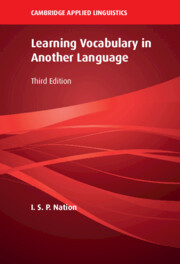Book contents
- Learning Vocabulary in Another Language
- The Cambridge Applied Linguistics Series
- Learning Vocabulary in Another Language
- Copyright page
- Contents
- List of figures
- List of tables
- Acknowledgements
- Introduction
- 1 The goals of vocabulary learning
- 2 Knowing a word
- 3 Teaching vocabulary and the roles of the teacher
- 4 Vocabulary and listening and speaking
- 5 Vocabulary and reading and writing
- 6 Learning vocabulary out of class
- 7 Vocabulary in specialised areas
- 8 Vocabulary-learning strategies and autonomy
- 9 Learning words from context
- 10 Word parts
- 11 Deliberate vocabulary learning from word cards
- 12 Finding and learning multiword units
- 13 Testing vocabulary knowledge and use
- 14 Designing the vocabulary component of a language course
- Book part
- References
- Author index
- Subject index
5 - Vocabulary and reading and writing
Published online by Cambridge University Press: 02 June 2022
- Learning Vocabulary in Another Language
- The Cambridge Applied Linguistics Series
- Learning Vocabulary in Another Language
- Copyright page
- Contents
- List of figures
- List of tables
- Acknowledgements
- Introduction
- 1 The goals of vocabulary learning
- 2 Knowing a word
- 3 Teaching vocabulary and the roles of the teacher
- 4 Vocabulary and listening and speaking
- 5 Vocabulary and reading and writing
- 6 Learning vocabulary out of class
- 7 Vocabulary in specialised areas
- 8 Vocabulary-learning strategies and autonomy
- 9 Learning words from context
- 10 Word parts
- 11 Deliberate vocabulary learning from word cards
- 12 Finding and learning multiword units
- 13 Testing vocabulary knowledge and use
- 14 Designing the vocabulary component of a language course
- Book part
- References
- Author index
- Subject index
Summary
In the reading section of this chapter, we look at how much vocabulary is needed to gain meaning-focused input through reading material written for native speakers. We then look at what a well-balanced reading program for learners of English as a foreign language should contain to maximise vocabulary growth, stressing the need to use vocabulary graded material, particularly graded readers. Such a course should provide opportunities for extensive reading, a focus on language features through intensive reading, and the development of reading fluency though speed reading. Finally, we look at how learners can be supported to read ungraded texts, using techniques such as narrow reading, pre–teaching, intensive reading, and glossing. In order to gain 98 per cent coverage of unsimplified text, learners need to know most of the high-frequency and mid-frequency words, totalling around 8,000–9,000 word families. In the writing section of this chapter, we look at the effect of vocabulary use on the quality of writing, measuring written productive knowledge of vocabulary and how to improve learners’ vocabulary use in writing.
Keywords
- Type
- Chapter
- Information
- Learning Vocabulary in Another Language , pp. 194 - 241Publisher: Cambridge University PressPrint publication year: 2022



